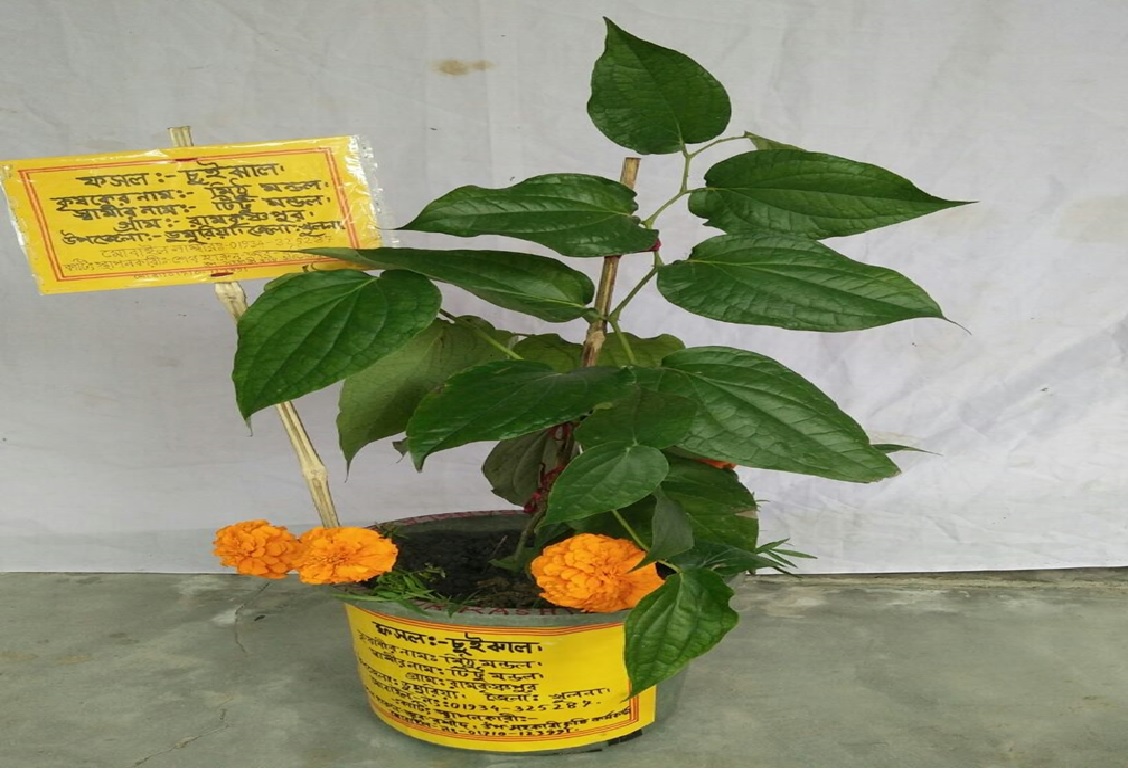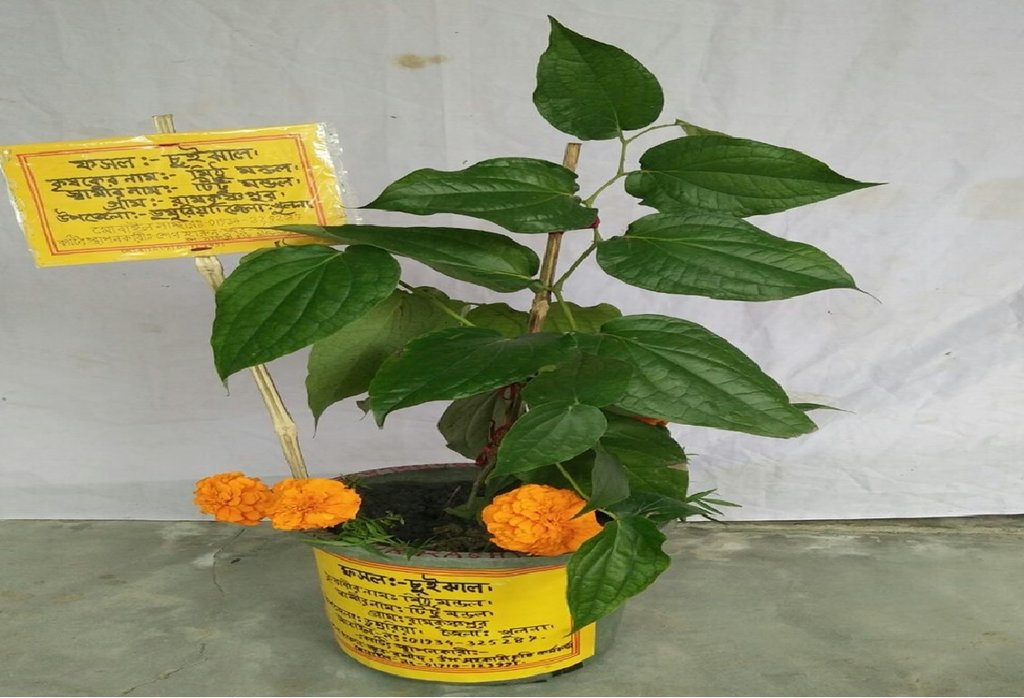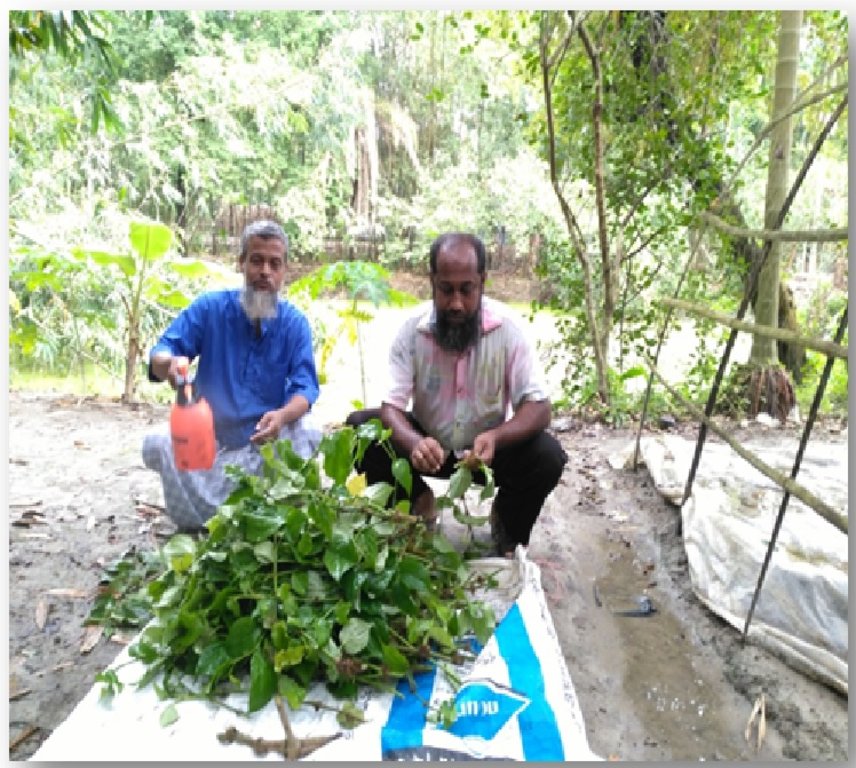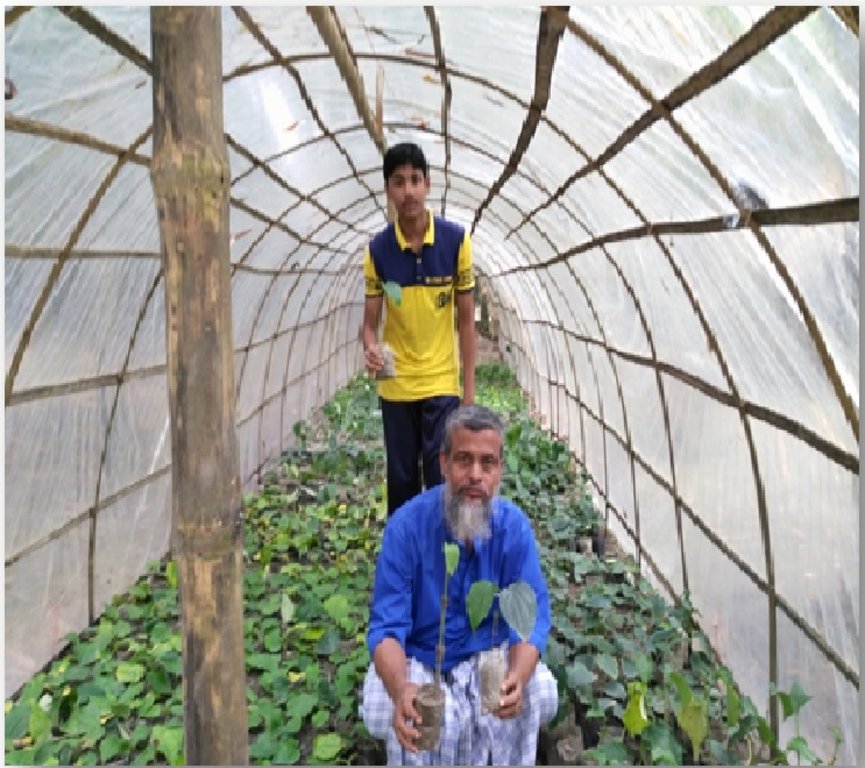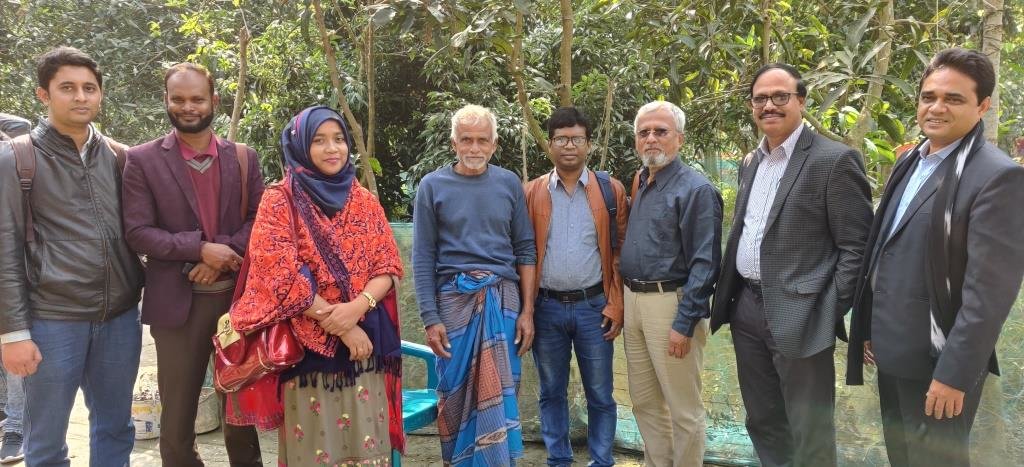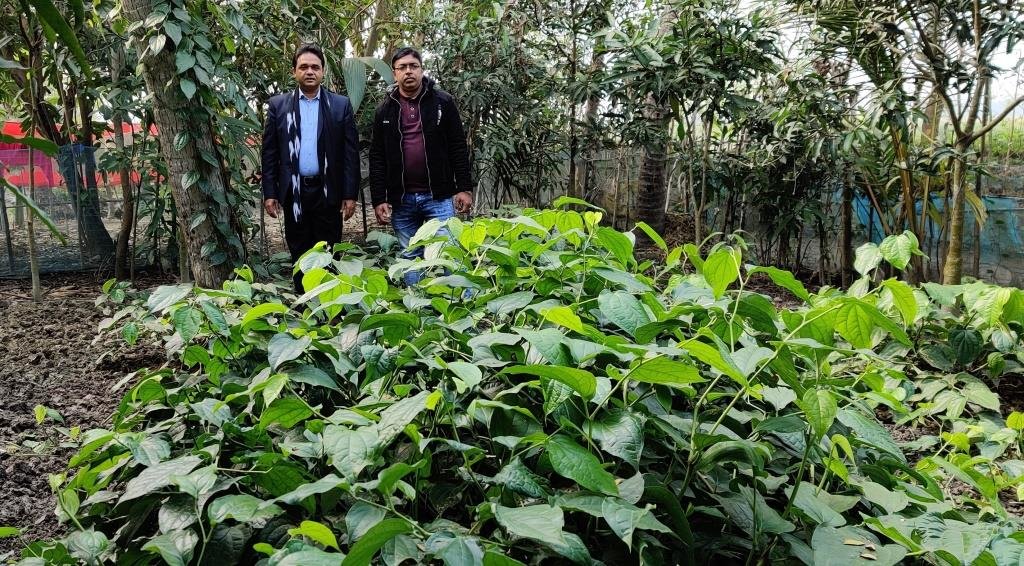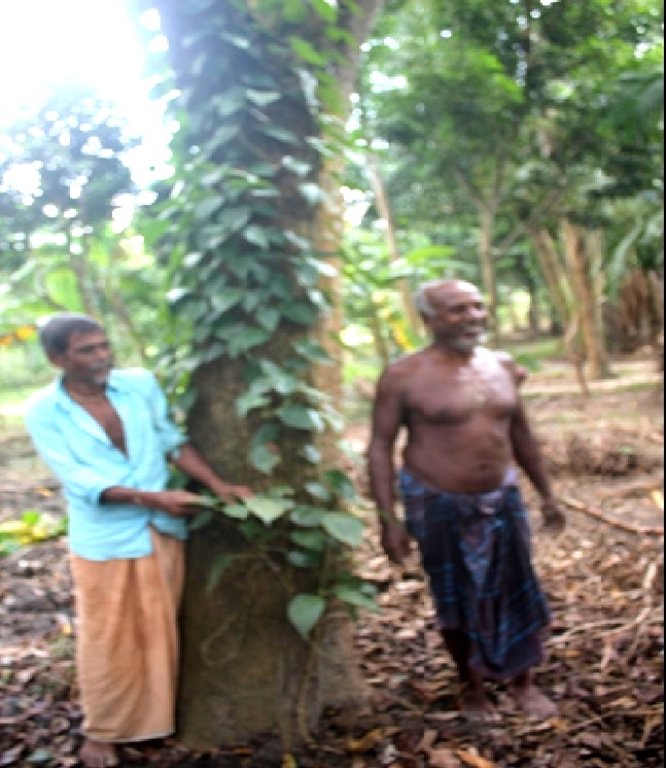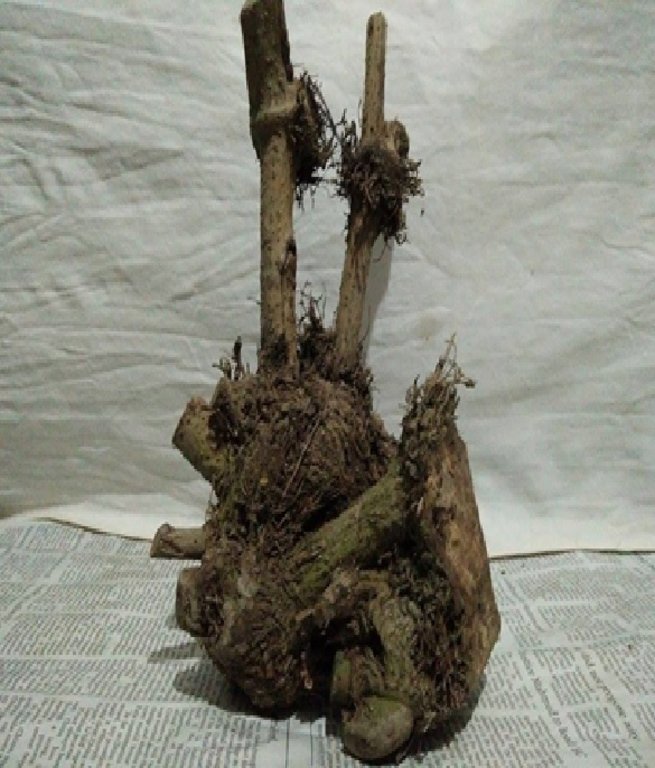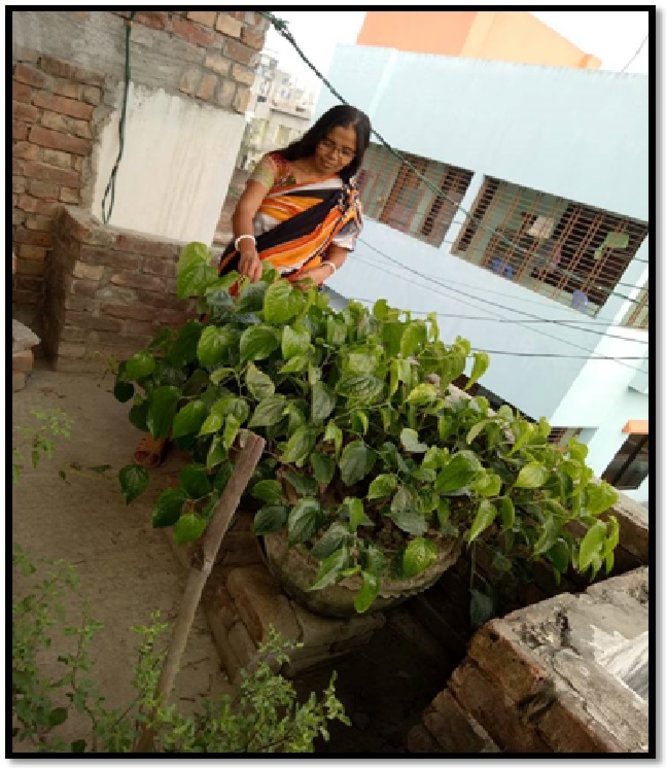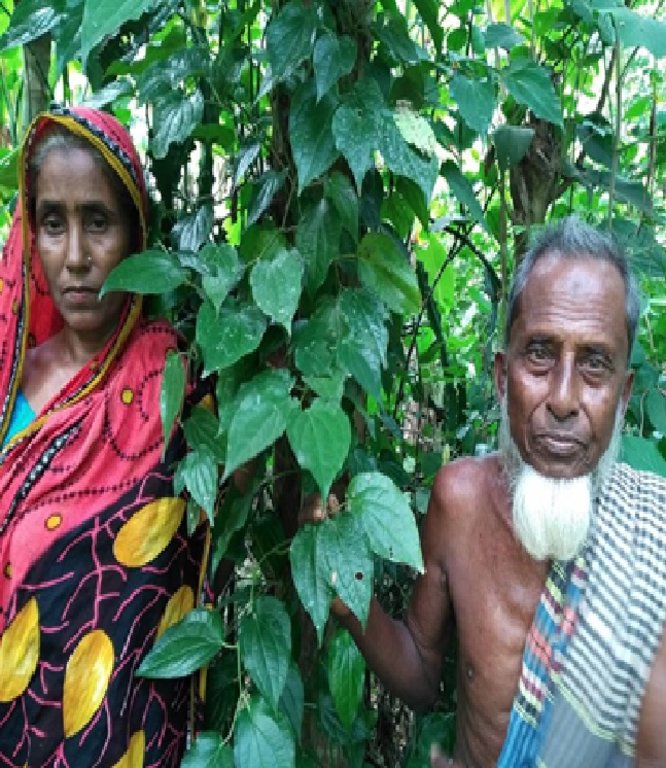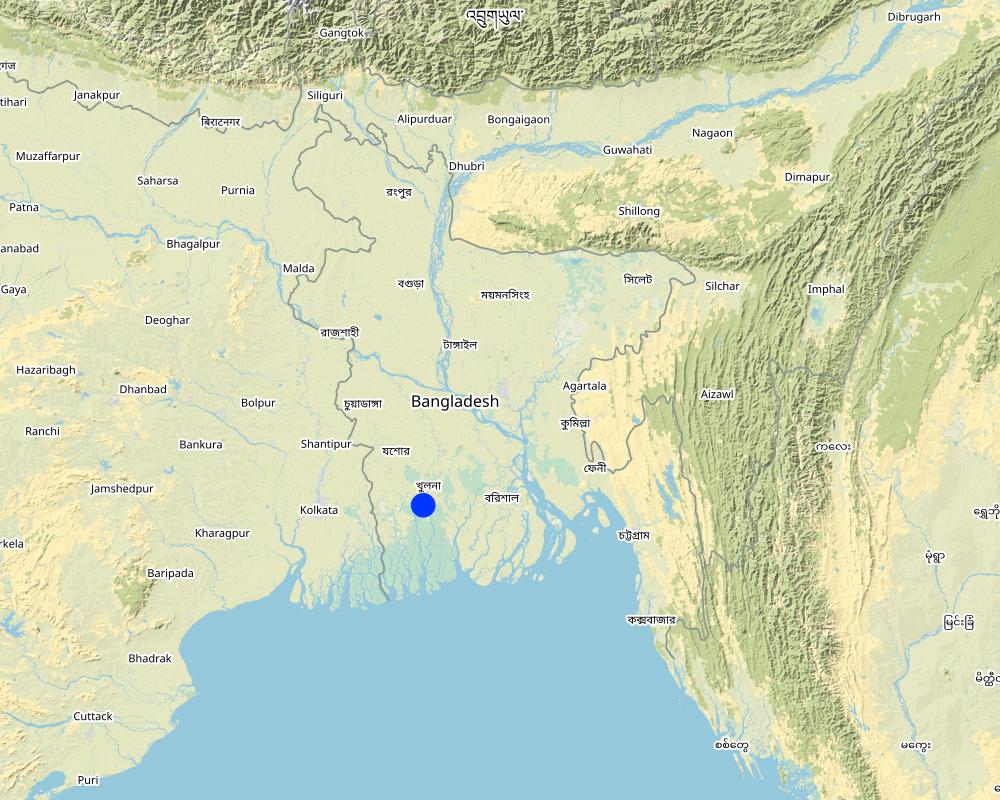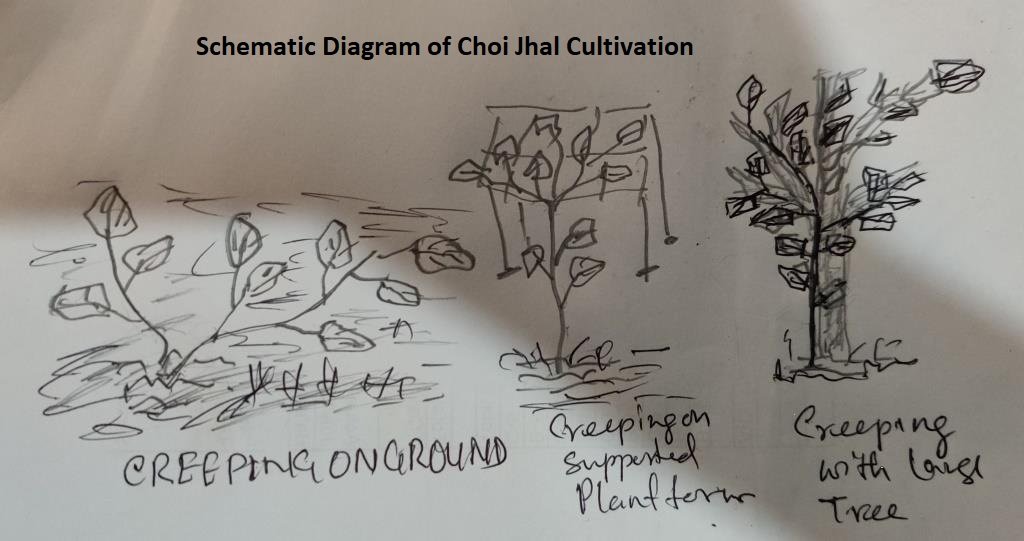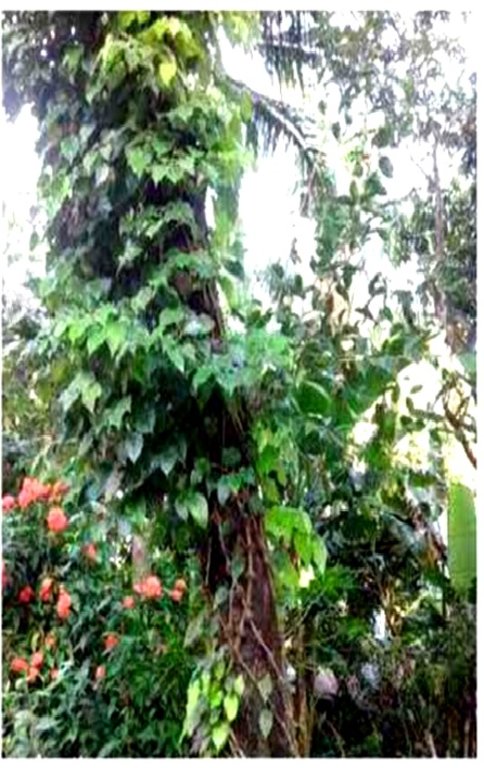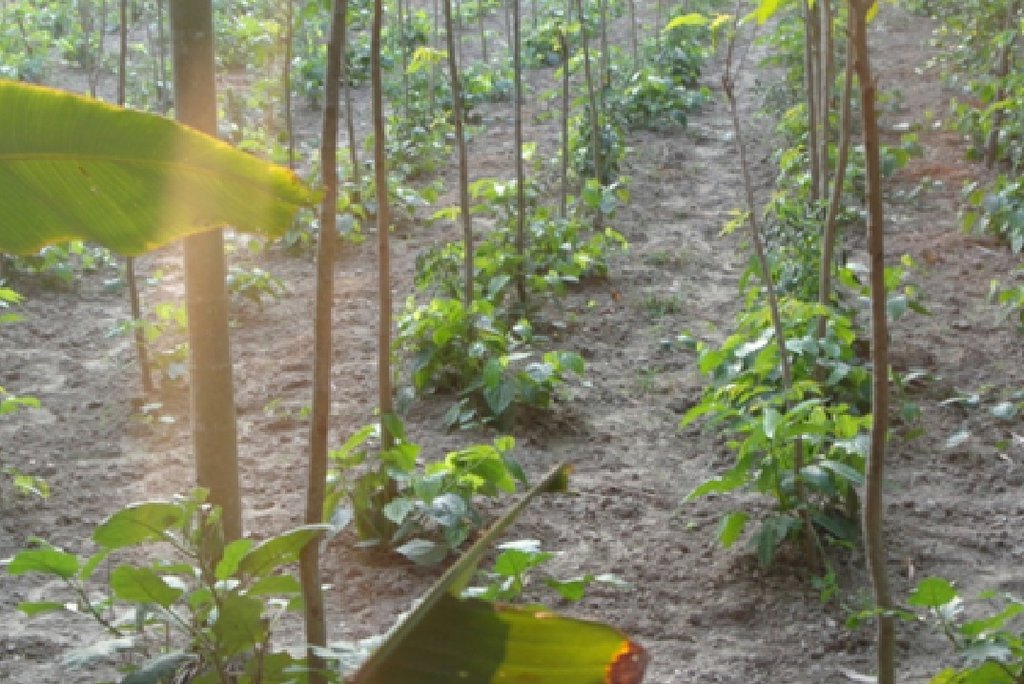Choi cultivation- a profitable crop for saline areas of Bangladesh [Bangladesh]
- Creation:
- Update:
- Compiler: Jalal Uddin Md. Shoaib
- Editor: –
- Reviewers: Rima Mekdaschi Studer, William Critchley
Morich lota chash
technologies_5769 - Bangladesh
View sections
Expand all Collapse all1. معلومات عامة
1.2 Contact details of resource persons and institutions involved in the assessment and documentation of the Technology
Key resource person(s)
co-compiler:
Islam Nazrul
Department of Agricultural Extension, Khulna
Bangladesh
Name of project which facilitated the documentation/ evaluation of the Technology (if relevant)
Establishing National Land Use and Land Degradation Profile toward Mainstreaming SLM Practices in Sector Policies (ENALULDEP/SLM)1.3 Conditions regarding the use of data documented through WOCAT
The compiler and key resource person(s) accept the conditions regarding the use of data documented through WOCAT:
نعم
1.4 Declaration on sustainability of the described Technology
Is the Technology described here problematic with regard to land degradation, so that it cannot be declared a sustainable land management technology?
لا
2. Description of the SLM Technology
2.1 Short description of the Technology
Definition of the Technology:
Choi Jhal (Piper chaba), locally called morich lota is a creeping vine that is grown in homesteads of saline areas. It is adapted to soil salinity, grows under shade and is a very high value crop. It remains green throughout the year, reducing evapotranspiration from the soil and hence reduces capillary rise of salinity from shallow ground water.
2.2 Detailed description of the Technology
Description:
Choi Jhal (Piper chaba), locally called morich lota is a creeping vine that is grown in homesteads of saline areas. It is adapted to soil salinity, grows under shade and is a very high value crop. It remains green throughout the year, reducing evapotranspiration from the soil and hence reduces capillary rise of salinity from shallow ground water. Choi Jhal locally called morich lota, is one of the most popular and unique spices in the south-western region of Bangladesh. It is a flowering vine grown in southern-western districts like Khulna and Satkhira. There are two types of choi found in these areas. One is a narrow vine (20 - 25 mm diameter) and the other is about 2. 5 - 5 cm in diameter. It creeps up to 8-10 meters when allowed to extend on ground. On the other hand it also climb up large trees like Mango (Mangifera indica), Jam (Syzygium cumini), Betel nut (Areca catechu), Coconut (Cocos nucifera) and Kafula (Lannea coromandelica), etc. Leaves and stems of the choi vine look like betel leafs (local name Paan; scientific name: Piper betle). Betel and choi are two species of the same family, Piperaceae. The leaves of choi are oval-shaped and about 5-6 cm long. The flowers are monoecious and blossom during the monsoon. The fruit looks similar to other varieties of long pepper, with an elongated shape that can grow up to 6 cm inches long. The fruit is red when ripe, and turns dark brown or black when dry. Chopped parts of the plant are cooked them with meat and fish, especially with mutton. The spicy pungent flavor of Choi Jhal is a year-round additive spice. In Thailand, P. chaba is known commonly as "Dee Plee”.
This technology was documented as one of the best practices that supports improved livelihoods of farmers who have no, or very little, cultivable land except their home yards. It is adapted to seasonal salinity in the dry season and waterlogging in monsoon. Pankhali is a village of Dacop Upazalia, Khulna where most of farmer practiced choi cultivation as their main income source. It is easy to propagate with cuttings of vines ideally of 50-75 cm with at least 4-5 nodes. Generally no chemical fertilizer is used for its cultivation, rather domestic waste or compost is used in ‘pits’ at the time of planting vine cuttings. The cuttings of vines are planted in April-May or November-December in relatively higher areas of the home gardens, with loamy soils. Choi is shade-loving. Approximately 2-2.5 ton/ha could be harvested after 5-6 years. It could be harvested after one year, but ideally it is better to harvest after 5 years. Farmers earn 1,000-1,500 BDT (US$1= 84 BDT) per kg from 5-year old choi. The mature roots are more valuable than the green vine. These days this product is marketed by many departmental stores of the city.
This expensive spice has great medicinal value, and tastes like pepper. It has been used to treat different kinds of diseases and it has a number of herbal uses, specially the antimicrobial and antioxidant active ingredients, Choi has 7% aromatic oil, 5% alkoloid and pepertin and in roots 13-15% peperin. The people of the area believe that it helps to remedy various diseases. One inch of choi can be used as medication for coughs. Its price depends on its thickness, and different thicknesses of Piper chaba taste different. Thicker ones are popular for its flesh and thinner ones for their spicy heat.
Commonly the twigs, stems or roots both fresh and dried forms are used in this area as a spice. Sometimes it is ground and used as an ingredient in a variety of sauces and pastes. It is a relatively expensive spice and the roots are usually more expensive than the stems because of their stronger aroma. It is mainly used as a taste enhancer. It makes the food spicier. It is also used in Jhalmori, Pickles, Halim and for making tasty soups.
2.3 Photos of the Technology
2.5 Country/ region/ locations where the Technology has been applied and which are covered by this assessment
بلد:
Bangladesh
Further specification of location:
It is spread over most of the districts of Khulna division
Specify the spread of the Technology:
- evenly spread over an area
If precise area is not known, indicate approximate area covered:
- 10-100 km2
Is/are the technology site(s) located in a permanently protected area?
لا
Comments:
Choi Jhal is grown in most of the homesteads as a valuable crop.
Map
×2.6 Date of implementation
If precise year is not known, indicate approximate date:
- 10-50 years ago
2.7 Introduction of the Technology
Specify how the Technology was introduced:
- through land users' innovation
- as part of a traditional system (> 50 years)
3. Classification of the SLM Technology
3.1 Main purpose(s) of the Technology
- improve production
- reduce, prevent, restore land degradation
- create beneficial economic impact
- cover crop when allowed to creep on ground
3.2 Current land use type(s) where the Technology is applied
Land use mixed within the same land unit:
لا

الأراضي الزراعية
- Perennial (non-woody) cropping
Perennial (non-woody) cropping - Specify crops:
- herbs, chili, capsicum

Other
حددها:
Homestead area
Remarks:
A small part of homesteads are used to grow Choi Jhal or it is planted near a larger tree like Mango, Kafula ( Lenea coromondalica), coconut etc. It is a shade-loving crop. Therefore homesteads are best for this crop.
3.3 Has land use changed due to the implementation of the Technology?
Has land use changed due to the implementation of the Technology?
- No (Continue with question 3.4)

Other
حددها:
Homestead areas
3.4 Water supply
Water supply for the land on which the Technology is applied:
- mixed rainfed-irrigated
Comments:
It may require occasional irrigation at the initial stage
3.5 SLM group to which the Technology belongs
- home gardens
3.6 SLM measures comprising the Technology

agronomic measures
- A1: Vegetation/ soil cover
- A2: Organic matter/ soil fertility
3.7 Main types of land degradation addressed by the Technology

chemical soil deterioration
- Cs: salinization/ alkalinization

other
حددها:
It helps to reduce soil salinity
3.8 Prevention, reduction, or restoration of land degradation
Specify the goal of the Technology with regard to land degradation:
- not applicable
4. Technical specifications, implementation activities, inputs, and costs
4.1 Technical drawing of the Technology
Technical specifications (related to technical drawing):
Choi Jhal (Piper chaba) vines are generally grown as farmers choice, where they are mainly allowed to creep along the ground or allowed to creep up large trees like Mango, Kafula, Coconut etc. Vines are planted in small pits filled with kitchen waste or compost. Vines generally are 50-75 cm with 4-5 nodes.
Author:
jalal Uddin Md. Shoaib
Date:
07/01/2020
Technical specifications (related to technical drawing):
Choi Jhal creeping with large tree
Author:
jalal Uddin Md. Shoaib
Date:
07/01/2020
Technical specifications (related to technical drawing):
Choi Jhal Creeping with stick to climb on platform
Author:
jalal Uddin Md. Shoaib
Date:
07/01/2020
4.2 General information regarding the calculation of inputs and costs
Specify how costs and inputs were calculated:
- per Technology area
Indicate size and area unit:
approximately 0.01ha
other/ national currency (specify):
BDT
If relevant, indicate exchange rate from USD to local currency (e.g. 1 USD = 79.9 Brazilian Real): 1 USD =:
84,95
Indicate average wage cost of hired labour per day:
500
4.3 Establishment activities
| Activity | Timing (season) | |
|---|---|---|
| 1. | Bed or PIT preparation | April-May, Nov-Dec |
| 2. | Planting | April-May, Nov-Dec |
4.4 Costs and inputs needed for establishment
| Specify input | Unit | Quantity | Costs per Unit | Total costs per input | % of costs borne by land users | |
|---|---|---|---|---|---|---|
| Labour | Labour | 1 | 4,0 | 500,0 | 2000,0 | 100,0 |
| Plant material | Cuttings/ vine of Choi (Own produce) | 1 | 20,0 | 10,0 | 200,0 | |
| Fertilizers and biocides | Compost (Own) | LS | 1,0 | 50,0 | 50,0 | |
| Total costs for establishment of the Technology | 2250,0 | |||||
| Total costs for establishment of the Technology in USD | 26,49 | |||||
If you are unable to break down the costs in the table above, give an estimation of the total costs of establishing the Technology:
2250,0
If land user bore less than 100% of costs, indicate who covered the remaining costs:
100%
4.5 Maintenance/ recurrent activities
| Activity | Timing/ frequency | |
|---|---|---|
| 1. | Watch and ward | as necessary |
4.6 Costs and inputs needed for maintenance/ recurrent activities (per year)
If you are unable to break down the costs in the table above, give an estimation of the total costs of maintaining the Technology:
500,0
If land user bore less than 100% of costs, indicate who covered the remaining costs:
100%
Comments:
It is very easy to maintain. Only to look after the crop while creeping.
4.7 Most important factors affecting the costs
Describe the most determinate factors affecting the costs:
not applicable
5. Natural and human environment
5.1 Climate
Annual rainfall
- < 250 mm
- 251-500 mm
- 501-750 mm
- 751-1,000 mm
- 1,001-1,500 mm
- 1,501-2,000 mm
- 2,001-3,000 mm
- 3,001-4,000 mm
- > 4,000 mm
Agro-climatic zone
- sub-humid
5.2 Topography
Slopes on average:
- flat (0-2%)
- gentle (3-5%)
- moderate (6-10%)
- rolling (11-15%)
- hilly (16-30%)
- steep (31-60%)
- very steep (>60%)
Landforms:
- plateau/plains
- ridges
- mountain slopes
- hill slopes
- footslopes
- valley floors
Altitudinal zone:
- 0-100 m a.s.l.
- 101-500 m a.s.l.
- 501-1,000 m a.s.l.
- 1,001-1,500 m a.s.l.
- 1,501-2,000 m a.s.l.
- 2,001-2,500 m a.s.l.
- 2,501-3,000 m a.s.l.
- 3,001-4,000 m a.s.l.
- > 4,000 m a.s.l.
Indicate if the Technology is specifically applied in:
- not relevant
5.3 Soils
Soil depth on average:
- very shallow (0-20 cm)
- shallow (21-50 cm)
- moderately deep (51-80 cm)
- deep (81-120 cm)
- very deep (> 120 cm)
Soil texture (topsoil):
- medium (loamy, silty)
Soil texture (> 20 cm below surface):
- medium (loamy, silty)
Topsoil organic matter:
- high (>3%)
5.4 Water availability and quality
Ground water table:
5-50 m
Availability of surface water:
medium
Water quality (untreated):
unusable
Water quality refers to:
surface water
Is water salinity a problem?
نعم
Is flooding of the area occurring?
لا
5.5 Biodiversity
Species diversity:
- high
Habitat diversity:
- high
5.6 Characteristics of land users applying the Technology
Sedentary or nomadic:
- Sedentary
Market orientation of production system:
- mixed (subsistence/ commercial)
Off-farm income:
- less than 10% of all income
Relative level of wealth:
- poor
- average
Individuals or groups:
- individual/ household
Level of mechanization:
- manual work
Gender:
- women
- men
Age of land users:
- middle-aged
- elderly
5.7 Average area of land used by land users applying the Technology
- < 0.5 ha
- 0.5-1 ha
- 1-2 ha
- 2-5 ha
- 5-15 ha
- 15-50 ha
- 50-100 ha
- 100-500 ha
- 500-1,000 ha
- 1,000-10,000 ha
- > 10,000 ha
Is this considered small-, medium- or large-scale (referring to local context)?
- small-scale
5.8 Land ownership, land use rights, and water use rights
Land ownership:
- individual, titled
Land use rights:
- open access (unorganized)
- individual
Water use rights:
- open access (unorganized)
Are land use rights based on a traditional legal system?
نعم
5.9 Access to services and infrastructure
health:
- poor
- moderate
- good
education:
- poor
- moderate
- good
technical assistance:
- poor
- moderate
- good
employment (e.g. off-farm):
- poor
- moderate
- good
markets:
- poor
- moderate
- good
energy:
- poor
- moderate
- good
roads and transport:
- poor
- moderate
- good
drinking water and sanitation:
- poor
- moderate
- good
financial services:
- poor
- moderate
- good
6. Impacts and concluding statements
6.1 On-site impacts the Technology has shown
Socio-economic impacts
Income and costs
farm income
Comments/ specify:
Home yards could be used to grow Choi with other crops/vegetables.
Other socio-economic impacts
Adopt seasonal salinity in dry seaspm and some what water logging in monsoon; a high value crop that increased cash income.
Comments/ specify:
The coastal area is saline in dry season and water logging in monsoon restricts cropping through out the year. Choi is a high value spice crop, could be grown in small areas of homesteads with other crops like vegetables etc. Small farmers of the area use this crop to earn cash.
Specify assessment of on-site impacts (measurements):
Not applicable
6.2 Off-site impacts the Technology has shown
Specify assessment of off-site impacts (measurements):
Not applicable
6.3 Exposure and sensitivity of the Technology to gradual climate change and climate-related extremes/ disasters (as perceived by land users)
Comments:
Not applicable
6.4 Cost-benefit analysis
How do the benefits compare with the establishment costs (from land users’ perspective)?
Short-term returns:
positive
Long-term returns:
very positive
How do the benefits compare with the maintenance/ recurrent costs (from land users' perspective)?
Short-term returns:
very positive
Long-term returns:
very positive
6.5 Adoption of the Technology
- > 50%
If available, quantify (no. of households and/ or area covered):
Many of the homesteads already used to growing choi jahl
Of all those who have adopted the Technology, how many did so spontaneously, i.e. without receiving any material incentives/ payments?
- 91-100%
6.6 التكيف
Has the Technology been modified recently to adapt to changing conditions?
نعم
other (specify):
At present nursery has been emerging to market saplings of choi jhalet
Specify adaptation of the Technology (design, material/ species, etc.):
Nursery has been developed
6.7 Strengths/ advantages/ opportunities of the Technology
| Strengths/ advantages/ opportunities in the land user’s view |
|---|
| Can earn cash money |
| Can use for own family |
| Can be grown in small area in homesteads |
| Almost all parts of the Choi Jhal are edible |
| Strengths/ advantages/ opportunities in the compiler’s or other key resource person’s view |
|---|
| Easy to propagate |
| No use of chemical fertilizer |
| Marketing of the crop increased |
| Added menu of restaurants bigger cities |
6.8 Weaknesses/ disadvantages/ risks of the Technology and ways of overcoming them
| Weaknesses/ disadvantages/ risks in the land user’s view | How can they be overcome? |
|---|---|
| Fungus infection at early stage | Use of anti fungus |
| Weaknesses/ disadvantages/ risks in the compiler’s or other key resource person’s view | How can they be overcome? |
|---|---|
| Confined in Khulna division | Extension message could be developed |
| Preservation of green Choi | Harvesting matured parts or has to be market quickly. |
7. References and links
7.1 Methods/ sources of information
- field visits, field surveys
10 homesteads
- interviews with land users
10
- interviews with SLM specialists/ experts
2
- compilation from reports and other existing documentation
4
When were the data compiled (in the field)?
07/01/2020
7.3 Links to relevant online information
Title/ description:
Choi Jhal: The culinary fire of Bengal
URL:
https://www.dhakatribune.com/bangladesh/nation/2020/01/09/choi-jhal-the-culinary-fire-of-bengal
Title/ description:
Chui Jhal is a traditional Khulna's spice that brings water to the tongue
URL:
https://www.orchidshade.com/2020/09/chui-jhal-is-traditional-khulna-spice.html
Title/ description:
Piper chaba
URL:
https://en.wikipedia.org/wiki/Piper_chaba
7.4 General comments
The crop can be grown in small home gardens especially on higher ground. It is adapted to soil salinity, grows under shade and is a very high value crop. It remains green throughout the year, reducing evapotranspiration from the soil and hence reduces capillary rise of salinity from shallow ground water.
Links and modules
Expand all Collapse allLinks
No links
Modules
No modules


